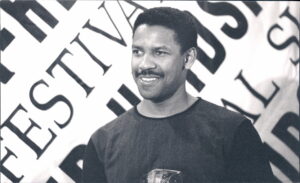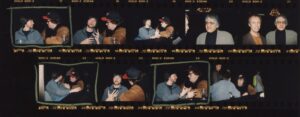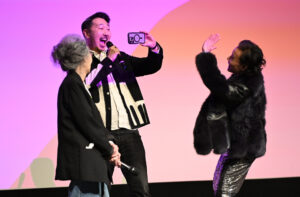By Bailey Pennick
Every time you watch a film, you’re taking a leap. A leap into someone else’s point of view, a leap into a new world, and a leap into another time and place. “That’s what I love about old movies,” says Jillian Borders over Zoom. “Getting this glimpse of what life was like…Seeing what people were wearing and what they were doing.” Borders, the head of Preservation at the UCLA Film & Television Archive, and her team have been working closely for years with Sundance Institute to preserve films from our history and expand the Sundance Collection at UCLA.
While film restoration might conjure images of dusty boxes and pre-code stories, Borders’ work on the Sundance Collection runs the gamut of our 40-plus year history, including films and times that might not feel so distant. “Historically, I find it interesting, especially working on a lot of ’90s films like Go Fish, it does really seem like a glimpse of life that’s familiar to me. But, also, I can almost barely remember now.”
This temporal looping is fitting for the UCLA Archives team, who is in the middle of a screening series “Science Fiction Against the Margins,” part of the Getty’s PST ART: Art & Science Collide initiative. “The Getty Pacific Standard Time Grant is four years: two years, which is research, and then, two years, which is actually mounting the exhibition,” explains Maya Montañez Smukler, UCLA’s Archive Research and Study Center Officer. A smile comes across her lips as she ponders the passage of time, “Finally it’s here.” The grin is warranted considering this behemoth of a project started as a collaborative idea from Cinema and Media Studies Professor Chon Noriega in December 2019. “We were supposed to turn in the applications in March 2020,” says Smukler. “It was, like, literally a week or two before the application was due we were told to leave our offices.”
As we were all put on pause during the early days of the COVID-19 pandemic, Smukler recalls how the UCLA team stayed the course. “To be watching a billion science fiction films and thinking through what science fiction outside of dominant cinema might be during a moment that, in a lot of ways, was super sci-fi. [It was] interesting and intense and hilarious [laughs].” The final result of all that pandemic viewing culminated in a rich program that highlights films from across the globe, including one of Borders’ more recent projects — the Sundance Collection restoration of writer-director Hilary Brougher’s 1997 feature The Sticky Fingers of Time.

Brougher, an alum of both the Institute’s labs as well as the Film Festival with 2006’s Stephanie Daley, takes on time travel and genre bending within her debut film. According to the UCLA program, The Sticky Fingers of Time has an “intricate time-travel storyline that plays like a non-linear murder mystery with an interesting mix of themes: mid-century H-bomb hysteria, ’90s arthouse angst and queer/lesbian chic power dynamics.”
Even the physical composition of Sticky Fingers defies categorization, which proved to be an interesting challenge for Borders. “This film was pretty complicated,” she recalls. “Like 30% of it is in black and white, and then a lot of it is in color. They use different [film] stocks to show different periods of time — you know, so black-and-white in the ’50s and color in the ’90s — but then they used a different film stock for other flashbacks. A lot of that is just kind of lost in the previous transfer.”
Bringing this boundless saga back into the light sparks cultural conversation according to Smukler and her team. “One of the central things to ‘Science Fiction Against the Margins’ is that, in this series, the films are made in the margins of dominant cinema, of mainstream cinema, of Hollywood cinema, but that’s also a really diverse range,” she explains. Smukler, who also wrote 2018’s Liberating Hollywood: Women Directors and the Feminist Reform of 1970s American Cinema, is passionate about uplifting diverse storytellers and voices. Borders agrees that this slate is one way to further that work. “It’s interesting to be able to give some of those filmmakers a voice now,” she says before a pause. “Like, just getting people out to see them again. A second chance to rediscover… the films that weren’t really given the voice that they deserved back then.”
Preserving independent film acts as a megaphone for those voices and ideas. By ensuring the next generation can engage with these stories, we continue to expand the framing of cinematic history. “Independent films — if they weren’t part of a studio — they’re just in someone’s garage or the tape elements have been lost. By Hook or By Crook [2002 Sundance Film Festival] is one of the first digital video projects. They used, like, Final Cut One to edit their film,” says Borders with a laugh. “A lot of these things that are on this cusp of changing technology are vulnerable.”
“Independent filmmakers who tend to need more advocacy, I think, [their projects are] a really big part of our conservation and preservation work,” reflects Smukler. The Sundance Collection at UCLA, which is already over 4,200 projects strong, continues to grow thanks in large part to Smukler, Borders, and their teams. With every frame preserved we travel back to a time and place where inspiration took hold and a necessary story was captured.










